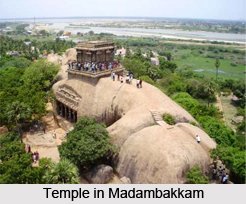 Madambakkam is a small settlement situated in Kanchipuram District of the southern state of India, Tamil Nadu.
Madambakkam is a small settlement situated in Kanchipuram District of the southern state of India, Tamil Nadu.
Location of Madambakkam
Madambakkam is located close to Tambaram and can be reached by road. Geographically, the town is located between 12.85 degree North latitude and 80.05 degree East longitude at an altitude of 29 metres (95 feet) above mean sea level. Formerly Madambakkam was known as Ulaguyyavanda-Chola Chaturvedimangalam. It was a part of the ancient territorial sub division called Nedugunra Nadu in Puliyur-Kottam, Jayamkonda-Cholamandalam.
Geography of Madambakkam
Madambakkam is spread over an area of 8 square kilometers. and is surrounded by Sholinganallur in the east, Vandalur in the southeast, Sembakkam in the north, Peerakankaranai in the west. Injambakkam in the southeast and Tambaram in the northwest. Chennai, the state capital is located at a distance of 37 km. from Madambakkam.
Demography of Madambakkam
According to the Population census in the year 2001, Madambakkam had a population of 16,556. The males and females comprise of an equal proportion of the population. In Madambakkam, 9 percent of the population is less than six years of age.
Education of Madambakkam
The literacy rate of Madambakkam is 82%. It is higher than the national average literacy rate, which is 59.5%. To be specific, the male literacy rate is 85% and the female literacy rate is 78%.
Economy of Madambakkam
Madambakkam is one of the biggest industrial estates in South Asia. Ambattur is situated 31 km. from this panchayat town. Madambakkam is well connected to the other places in the state.
Tourism in Madambakkam
The prime attraction of Madambakkam is the ancient Dhenupureeswarar Temple dedicated to Lord Shiva or Mahadeva. The Archaeological Survey of India looks after this temple. Near the Dhenupureeswarar temple lies the Madambakkam Temple Complex. Other tourist attractions in the vicinity are Vandalur Zoo, Pichaleeswarar Temple at Panapakkam, Sri Rama Anjaneya Temple, Pallavaram and Nanganallur.
Visiting Information
The nearest airport is the Chennai International Airport and the nearest railway station is the Tambaram Railway Station.



















